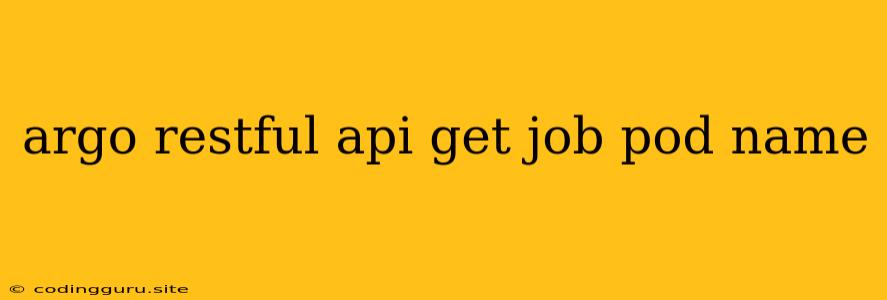How to Get a Job Pod Name Using the Argo RESTful API
In the dynamic world of Kubernetes, managing and monitoring your workloads often requires understanding the specifics of individual pods. This is particularly crucial when using Argo Workflows, a powerful tool for orchestrating complex, multi-step processes. Knowing the name of the pod running your job is essential for debugging, resource allocation, and other vital tasks.
Understanding the Basics: Argo Workflows and Pods
Before diving into the specifics of retrieving pod names, let's clarify some foundational concepts:
- Argo Workflows: A Kubernetes-native workflow engine that allows you to define and execute complex workflows as a series of steps (pods) within a Kubernetes cluster.
- Pods: The smallest deployable unit in Kubernetes, representing a container or set of containers running a specific application or task.
So, how do we get the name of the pod that's running our job within an Argo Workflow? This is where the Argo RESTful API comes to the rescue.
Using the Argo RESTful API to Retrieve Pod Names
The Argo RESTful API provides a powerful interface for interacting with your workflows. You can use the API to view the status of workflows, get information about individual steps, and, crucially, retrieve the names of pods associated with those steps.
Let's break down the process:
1. Accessing the Argo API:
- The Argo API typically runs on a specific port (usually 8080) on your Kubernetes cluster.
- You can access it through the following URL:
https://<argo-api-host>:8080/api/v1 - For authentication, you might need to use a token or other authorization methods depending on your cluster configuration.
2. Identifying the Workflow:
- To get the pod name, you'll first need to identify the specific workflow you're interested in. This usually involves specifying the workflow's namespace and name in the API endpoint.
3. Requesting Pod Information:
- The Argo RESTful API offers various endpoints for retrieving information about workflows and their components.
- To get the pod name, you'll need to use the
getoperation on the/workflows/<workflow_name>endpoint.
4. Parsing the Response:
- The response to your API request will contain information about the workflow, including a list of its steps and the associated pods.
- You can use a programming language (like Python, Go, or JavaScript) to parse the response and extract the pod name.
Example with curl (for basic understanding):
curl -s -H "Authorization: Bearer your_token" \
-X GET "https://:8080/api/v1/workflows//" | \
jq -r '.status.nodes[].template.name'
This example uses the curl command-line tool and jq (a JSON processor) to retrieve and process the API response.
Working with the API Response
Once you have the API response, you'll need to parse it to extract the pod name. This usually involves:
- Identifying the correct step: Find the step within the workflow that corresponds to the job you're interested in.
- Retrieving the pod name: Within the step's information, you should find a field that indicates the pod's name.
Remember: The exact structure of the API response can vary depending on the version of Argo.
Important Considerations
- Error Handling: Implement robust error handling mechanisms to gracefully manage potential issues like network errors, API failures, or unexpected data formats.
- API Documentation: Refer to the official Argo documentation for comprehensive details about the API endpoints, data structures, and other relevant information.
Conclusion
Retrieving the pod name associated with an Argo workflow step using the RESTful API is a common and essential task. By understanding the API structure, utilizing appropriate tools, and incorporating error handling, you can seamlessly integrate this information into your monitoring and management processes.
